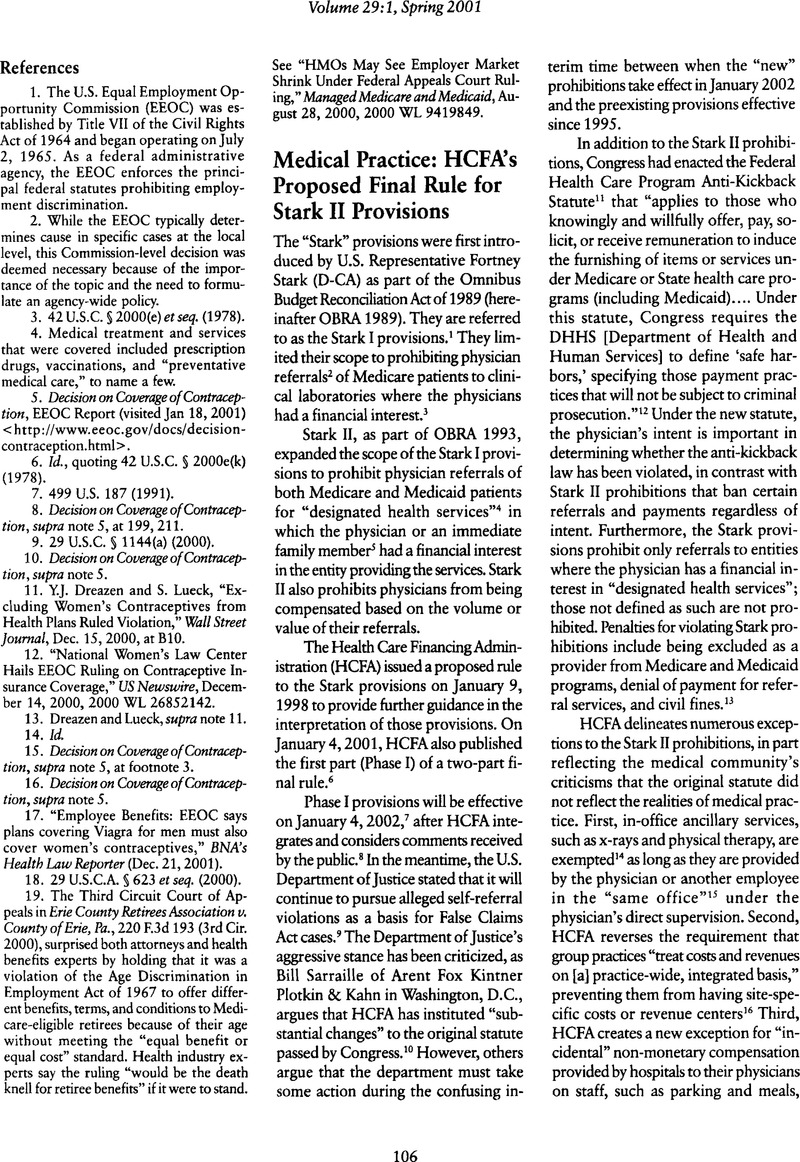No CrossRef data available.
Article contents
Medical Practice: HCFA's Proposed Final Rule for Stark II Provisions
Published online by Cambridge University Press: 01 January 2021
Abstract
An abstract is not available for this content so a preview has been provided. Please use the Get access link above for information on how to access this content.

- Type
- Article
- Information
- Copyright
- Copyright © American Society of Law, Medicine and Ethics 2001
References
OBRA 1989, including the Stark I provisions, was passed in December 1989 and published in the Federal Register on August 14, 1995. See American Association of Orthopaedic Surgeons, “Ban on Physician Self-Referral (The “Stark” Provisions)” (visited March 19, 2001) <http://www.aaos.org/wordhtml/papers/articles/selfref.htm> [hereinafter cited as “Ban on Physician Self-Referral”].+[hereinafter+cited+as+“Ban+on+Physician+Self-Referral”].>Google Scholar
The Stark Law defines “referral” as “the request by a physician for an item or services for which payment may be made under Part B [of Medicare], including the request for a consultation with another physician (and any test or procedure ordered by, or to be performed by (or under the supervision of) that other physician) … [and including] the request or establishment of a plan of care by a physician that includes the provision of a designated health service.” See Becker, Epstein & Green, P.C., “Proposed Stark II Regulations and Advisory Opinion Process: HCFA Seeking Public Comment on a Wide Range of Unanswered Questions” (visited March 19, 2001) <http://www.ebglaw.com/article_321.html> [hereinafter cited as “Proposed Stark II Regulations”].+[hereinafter+cited+as+“Proposed+Stark+II+Regulations”].>Google Scholar
A financial interest includes ownership, investment, or another compensation relationship with the entity providing the services. See “Ban on Physician Self-Referrals,” supra note 1.Google Scholar
“Designated health services” include clinical laboratory services (Stark I); physical therapy services; occupational therapy services; radiology therapy services; durable medical equipment; parenteral and enteral nutrients, equipment, and supplies; prosthetics, orthotics, and prosthetic devices; home health services; outpatient prescription drugs; and inpatient and outpatient hospital services. Id.Google Scholar
As defined by HCFA, an “immediate family member” is a spouse; natural or adoptive parent, child, or sibling; those related by marriage (e.g., stepbrother or father-in-law); grandparent or grandchild; or a spouse of a grandparent or grandchild. See id.Google Scholar
The HCFA document is at 66 Fed. Reg. 855. See Harris, Katherine, “Self-Referral: Part I of Two-Part Stark II Final Rule Eases Physician Supervision Requirements,” BNA's Health Law Reporter, 10 (January 11, 2001): At 63.Google Scholar
This is true for all of the provisions except those involving physician referrals to home health agencies, which become effective on February 5, 2001. Id.Google Scholar
HCFA will be accepting these comments until April 4, 2001. See id.Google Scholar
The preexisting statutory provisions have been effective since January 1, 1995, when Congress first enacted Stark II as law. HCFA issued a proposed rule on January 9, 1998 to provide guidance concerning compliance with the provisions, but this is not binding until the final rule is promulgated in 2002. This proposed rule was published in the Federal Register (1624–1728). See “Ban on Physician Self-Referral,” supra note 1.Google Scholar
See “Proposed Stark II Regulations,” supra note 2.Google Scholar
See “Ban on Physician Self-Referral,” supra note 1.Google Scholar
See id.Google Scholar
This is often referred to as the physician group practice exemption. A “physician group practice” is defined as a group where two or more physicians are legally organized and recognized as a business entity, with a single corporate or federal tax number and/or Medicare billing number, with shared space, billing, staff, equipment, and facilities. These group practices must also meet other strict requirements as defined by HCFA to be exempted from the statute. See “Ban on Physician Self-Referrals,” supra note 1.Google Scholar
HCFA specifically states that buildings that are connected by tunnels or are within the same complex do not constitute the “same office.” See Harris, , supra note 6.Google Scholar
See Harris, , supra note 6.Google Scholar
See “Proposed Stark II Regulations,” supra note 2.Google Scholar




